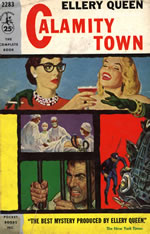Calamity Town
 Cover Artist: William George
Cover Artist: William GeorgeBy: Queen, Ellery pseudonym of Frederic Dannay and Manfred B. Lee
Publisher: Pocket Books, Inc. (2283)
Place of Publication:New York, NY
Catalog #: Kelley Box 354: PS3533 .U4 C24 1955
Contributor: P. Kearney
General
Era: 1940sAuthor as on Cover: Ellery Queen
Publication:1955
Original Date: 1942
Setting: downtown Wrightsville: a "big" small town; the Wright home: country estate; general atmosphere of a progressive country town on the verge of boom times
Plot Summary
Ellery Queen arrives in the fictional town of Wrightsville to begin work on a novel. He rents a house owned by the town's "first family," the Wrights. This house has come to be known as "Calamity House" due to some unfortunate events that occurred there, one involving Nora, middle daughter of the current matriarch and patriarch, Hermione and John. On the eve of Nora's wedding to Jim Haight three years earlier, the couple had a mysterious fight in the house and Jim left town. During Ellery's stay, Jim suddenly reappears, reconciles with Nora, and they marry. However, suspicions arise that Jim intends to murder Nora with arsenic, based on the discovery of three letters written by Jim which predict the "illness" and death of his wife over the Thanksgiving, Christmas, and New Year's holidays. The letters were found in a book titled "Edgecomb's Toxicology" between two pages dealing with arsenic. Sure enough, Nora becomes ill on the first two holidays, but on New Year's Eve, it is Jim's sister Rosemary, not Nora, who dies after sipping a poisoned drink. Ellery and Pat, Nora's younger sister, believe Jim is innocent, and work to find evidence to save him.Major Characters
Ellery Queen (uses the alias of Ellery Smith), adult male, estimated age in mid-30s, indications of average height and weight, above average strength, mystery novelistJames Haight "Jim," adult male, assume late 20s/early 30s, average height and weight, banker
Rosemary Haight adult female, assume late 20s/early 30s, slim, very attractive, sophisticated
Nora (Wright) Haight adult female, assume late 20s, slim, pale, fragile, often sickly, petite and underweight, nervous, homemaker
Patricia Wright "Pat," "Patty," adult female, assume mid-20s, slim, attractive, average height and weight
Carter Bradford "Cart," adult male, assume late 20s/early 30s, tall, handsome, strong, assistant district attorney
Roberta Roberts adult female, assume late 20s, attractive, average height and weight, journalist